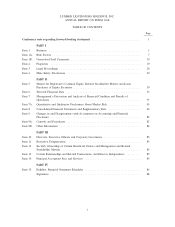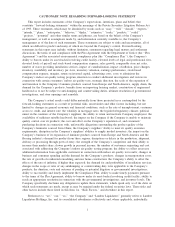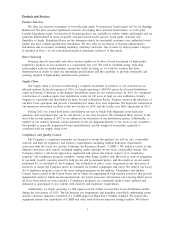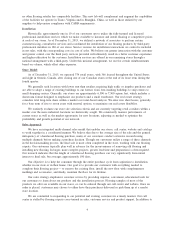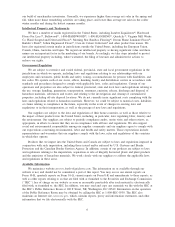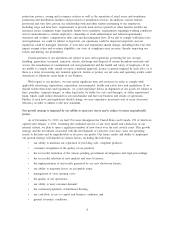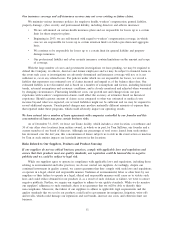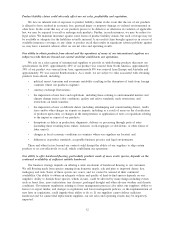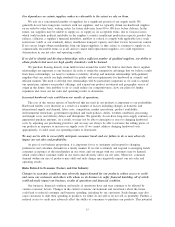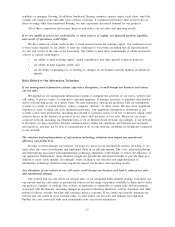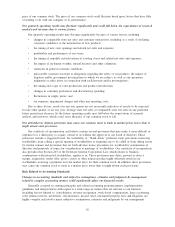Lumber Liquidators 2015 Annual Report Download - page 19
Download and view the complete annual report
Please find page 19 of the 2015 Lumber Liquidators annual report below. You can navigate through the pages in the report by either clicking on the pages listed below, or by using the keyword search tool below to find specific information within the annual report.In addition, the following may impact the net sales and performance of our new stores compared to
prior years:
• as we open more stores, our rate of expansion relative to the size of our store base will decline;
• we may not be able to identify suitable store locations in markets into which we seek to expand and
may not be able to open as many stores as planned;
• consumers in new markets may be less familiar with our brands, and we may need to increase brand
awareness in those markets through additional investments in advertising;
• new stores may have higher construction, occupancy or operating costs, or may have lower average
store net sales, than stores opened in the past;
• we may experience difficulties, delays or failures in obtaining the necessary licenses, permits or
other approvals necessary to open and operate particular store locations;
• we may incur higher maintenance costs than in the past;
• newly opened stores may not succeed or may reach profitability more slowly than we expect, and
the ramp-up to profitability may become longer in the future as we enter more mid-sized and smaller
markets and add stores to larger markets where we already have a presence; and
• future markets and stores may not be successful and, even if we are successful, our average store net
sales and our comparable store net sales may not increase at historical rates.
Finally, our progress in opening new stores from quarter to quarter may occur at an uneven rate, which
may result in quarterly net sales and profit growth falling short of market expectations in some periods.
Our net sales and profit growth could be adversely affected if comparable store net sales are less than we
expect.
While future net sales growth will depend substantially on our plans for new store openings, the level of
comparable store net sales (which represent the change in period-over-period net sales for stores beginning
their thirteenth full month of operation) will also affect our net sales growth and business results. Among
other things, increases in our baseline store volumes and the number of new stores opened in existing markets,
which tend to open at a higher base level of net sales, will impact our comparable store net sales. As a result,
it is possible that we will not achieve our targeted comparable store net sales growth or that the change in
comparable store net sales could be negative. If this were to happen, net sales and profit growth would be
adversely affected.
Increased transportation costs, particularly those relating to the cost of fuel, could harm our results of
operations.
The efficient transportation of our products through our supply chain is a critical component of our
operations. If the cost of fuel or other costs, such as import tariffs, duties and international container rates,
rise, it could result in increases in our cost of sales due to additional transportation charges and in the fees
delivery companies charge us to transport our products to our stores and customers. We may be unable to
increase the price of our products to offset increased transportation charges, which could cause our operating
results to deteriorate.
Business and operation risks exist in connection with our distribution centers.
In 2013, we purchased 110 acres of undeveloped land in Henrico County, Virginia upon which we
constructed a million square foot distribution center. The facility became fully operational in January 2015.
This was our first real estate purchase and is the first distribution center owned by us. The cost of operating
and managing the East Coast distribution center may exceed our expectations and we may not achieve the
benefits that we anticipate from consolidating our East Coast facilities into this East Coast distribution center.
In addition, since early 2014, we have leased and operated a 500,000 square foot distribution center in
Pomona, California, our first distribution center located outside of Virginia. The costs of operating may exceed
9


